Monkeying Around: A Practical Guide
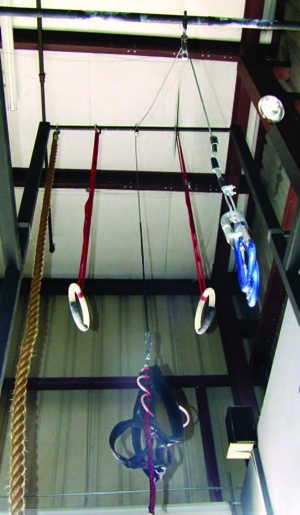
If you're reading this issue of the PM, then it means you already found your inner monkey and here we'll show you how to unleash its power!
Monkey bars are essential to CrossFit. Just like Concept 2 rowers, bumper plates and medicine balls can be found in any real functional training facility (green round objects and half round blue objects are found at phony functional training facilities).
We're going to talk briefly about why monkey bars are important (DUH section), how to design them, and how to upgrade them (the best part is left for dessert in the end).
DUH section
Let's put in brief what can and/or should be done on/with properly designed monkey bars:
• Kipping pullups by multiple people (this is going to be the most common use)
• Wall balls
• Ring muscle-ups, levers, skin-the-cats, crosses and everything else doable on the rings
• Bar muscle ups
• Rope climbs
• Hang heavy bags
• Elements of parkour and freerunning
• Multiple other uses depending on creativity of the designer. The list is endless.
Left over steel can be utilized for multiple purposes, like plate and barbell racks.
With so many opportunities in mind, our monkey bars have to be designed to be sturdy (several people doing kipping pull-ups simultaneously create an awful lot of momentum), and high enough to allow ring muscle-ups; They should also be reasonably priced when finished.
Let's address some of the issues above and do a little planning:
3-inch square steel works very well for the main skeleton. 1-inch to 1.25-inch is perfect pull-up bar diameter. 1.5-inch is great for guys, while gals seem to favor thinner bars. Those will become ribs of the construction. All welded together, it's bulletproof.
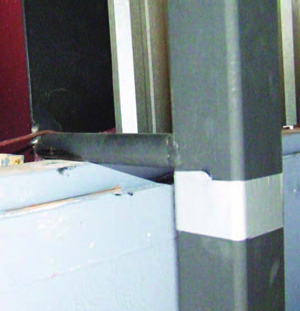
beamweld
Monkey bars should be anchored to the floor through L-brackets welded to the vertical support. If possible—or absolutely necessary when bars will only have two supporting vertical beams—weld/bolt the construction to the metal vertical beam of the warehouse (since that seems to be a very popular CF habitat) or bolted into the concrete wall. Now our construction won't go anywhere!

L-Bracket
Good height is 8ft to 8.5ft on the pull-up/monkey bars. For guys over six feet tall, 9ft-high pull-up bars are perfect. Plenty of room to kip! Having at least one section of higher bars allows for comfortable kipping ring muscle-ups.
Distance between the monkey bars is essential. If kipping pull-ups are the main goal, about 3ft in between is perfect. For playground type fun, 18" works wonders.
The set of monkey bars and 2 barbell/plate holders pictured in this article cost about $500 dollars for materials (Length is 20 feet, high bar at 15 feet. 1.5-inch-thick lower pull-up bars and 1.25-inch-thick monkey bars).
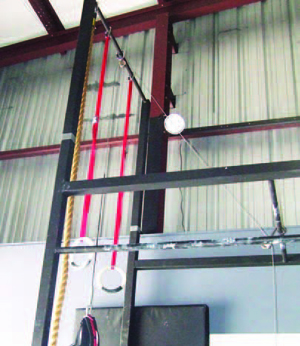
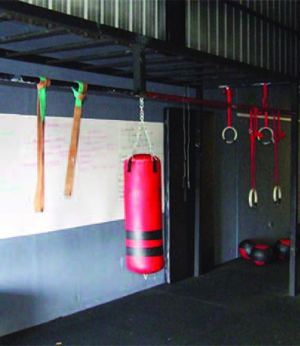
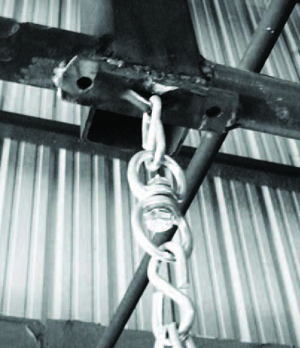
Monkey High Bar; Monkey Punching Bag, Punching Bag Hold
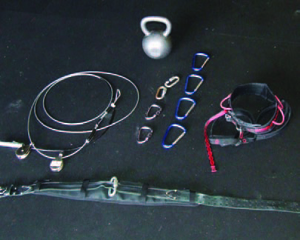
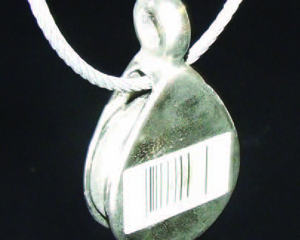
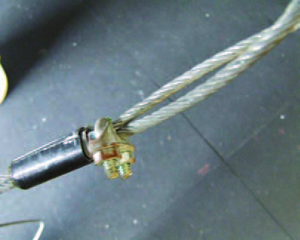
Pulley Equipment; Pulley; Wire Loop
Upgrading the Monkey Bars
• Wallball targets - Can be built right with the monkey bars or added on later.
• Rope climb - Short ropes can be hung to perform assisted rope climbs. Or if a set of monkey bars with a high bar was erected then get the rope around the bar and climb it. Works great if there are no available high beams.
• Storage - Crash mats can be put behind the support beams for easy storage.
• Pulley system - Assisted muscle-ups, iron crosses, inverts and the wonderful world of gymnastics opens its doors.
How to build a simple fixed pulley system
Requirements:
• 2 pulleys
• Carabiners - make sure that carabiners will fit around the bar!
• 1/4" steel wire
• Lower body harness (or any solid thick belt)
All that can be put together for less than a $100. Even less than $50 if using a belt vs. harness.

Step by step:
1. Attach pulleys. Use rope, more steel wire or hooks if building it in garage gym with wooden studs.
2. Put the wire through.
3. Attach the harness to the wire using a carabiner.
4. Adjust the wire on the opposite end. Cut and make a loop on the other end.
5. Strap yourself in, counterweight and enjoy!
For more theory and advanced pulley designs - go here
Conclusion
There's no conclusion to this article. It's time to build and exercise. The iron cross is waiting!
Monkey bars are essential to CrossFit. Just like Concept 2 rowers, bumper plates and medicine balls can be found in any real functional training facility (green round objects and half round blue objects are found at phony functional training facilities).
We're going to talk briefly about why monkey bars are important (DUH section), how to design them, and how to upgrade them (the best part is left for dessert in the end).
DUH section
Let's put in brief what can and/or should be done on/with properly designed monkey bars:
• Kipping pullups by multiple people (this is going to be the most common use)
• Wall balls
• Ring muscle-ups, levers, skin-the-cats, crosses and everything else doable on the rings
• Bar muscle ups
• Rope climbs
• Hang heavy bags
• Elements of parkour and freerunning
• Multiple other uses depending on creativity of the designer. The list is endless.
Left over steel can be utilized for multiple purposes, like plate and barbell racks.
With so many opportunities in mind, our monkey bars have to be designed to be sturdy (several people doing kipping pull-ups simultaneously create an awful lot of momentum), and high enough to allow ring muscle-ups; They should also be reasonably priced when finished.
Let's address some of the issues above and do a little planning:
3-inch square steel works very well for the main skeleton. 1-inch to 1.25-inch is perfect pull-up bar diameter. 1.5-inch is great for guys, while gals seem to favor thinner bars. Those will become ribs of the construction. All welded together, it's bulletproof.

beamweld
Monkey bars should be anchored to the floor through L-brackets welded to the vertical support. If possible—or absolutely necessary when bars will only have two supporting vertical beams—weld/bolt the construction to the metal vertical beam of the warehouse (since that seems to be a very popular CF habitat) or bolted into the concrete wall. Now our construction won't go anywhere!

L-Bracket
Good height is 8ft to 8.5ft on the pull-up/monkey bars. For guys over six feet tall, 9ft-high pull-up bars are perfect. Plenty of room to kip! Having at least one section of higher bars allows for comfortable kipping ring muscle-ups.
Distance between the monkey bars is essential. If kipping pull-ups are the main goal, about 3ft in between is perfect. For playground type fun, 18" works wonders.
The set of monkey bars and 2 barbell/plate holders pictured in this article cost about $500 dollars for materials (Length is 20 feet, high bar at 15 feet. 1.5-inch-thick lower pull-up bars and 1.25-inch-thick monkey bars).



Monkey High Bar; Monkey Punching Bag, Punching Bag Hold



Pulley Equipment; Pulley; Wire Loop
Upgrading the Monkey Bars
• Wallball targets - Can be built right with the monkey bars or added on later.
• Rope climb - Short ropes can be hung to perform assisted rope climbs. Or if a set of monkey bars with a high bar was erected then get the rope around the bar and climb it. Works great if there are no available high beams.
• Storage - Crash mats can be put behind the support beams for easy storage.
• Pulley system - Assisted muscle-ups, iron crosses, inverts and the wonderful world of gymnastics opens its doors.
How to build a simple fixed pulley system
Requirements:
• 2 pulleys
• Carabiners - make sure that carabiners will fit around the bar!
• 1/4" steel wire
• Lower body harness (or any solid thick belt)
All that can be put together for less than a $100. Even less than $50 if using a belt vs. harness.

Step by step:
1. Attach pulleys. Use rope, more steel wire or hooks if building it in garage gym with wooden studs.
2. Put the wire through.
3. Attach the harness to the wire using a carabiner.
4. Adjust the wire on the opposite end. Cut and make a loop on the other end.
5. Strap yourself in, counterweight and enjoy!
For more theory and advanced pulley designs - go here
Conclusion
There's no conclusion to this article. It's time to build and exercise. The iron cross is waiting!
|
Leo Soubbotine is an ISSA & CrossFit Certified trainer, strongman competitor, cross-country skier, and former collegiate and high school basketball and volleyball player. He trains for CrossFit Evolution in Longwood, Florida. |
Search Articles
Article Categories
Sort by Author
Sort by Issue & Date
Article Categories
Sort by Author
Sort by Issue & Date

